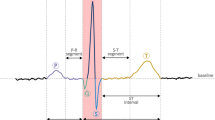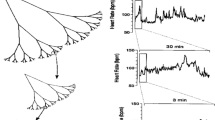Abstract
In this article, a highly adaptable method the empirical wavelet transform (EWT) is utilized to compress electrocardiogram (ECG) data. EWT and run-length encoding (RLE)-based technique is used for data compression of ECG rhythms. EWT is chosen because it is highly adaptable and can decompose a non-stationary signal into different frequency modes efficiently. The modified RLE is used to acquire the high reduction performance. The projected method is tested with MIT-BIH arrhythmia database and experiments are carried out in MATLAB R2016b. Performance of the proposed algorithm is evaluated in terms of compression ratio (CR), percent root mean squire difference (PRD), signal-to-noise ratio (SNR), retained energy (RE) and quality score (QS). Result shows a high CR (31%), low PRD (0.0750) and high QS (414). Comparative analysis of the performance of projected technique with several existing techniques is also done, which shows that the proposed technique is superior in terms of PRD and CR. WT is also used to detect the R-peaks (location and amplitude) using amplitude thresholding. The program took 4.452793 s to run.












Similar content being viewed by others
Data Availability
This data is download by (MIT/BIH arrhythmia database
References
Cromwell L, Weibell FJ, Pfeiffer EA (1980) Biomedical instrumentation and measurements. Prentice Hall, Hoboken
Raeiatibanadkooki M, Quchani SR, KhalilZade M, Bahaadinbeigy K (2016) Compression and encryption of ECG signal using wavelet and chaotically Huffman code in telemedicine application. J Med Syst 40(3):73
Chandra S, Sharma A, Singh GK (2017) Pa Denoising ECG signal: a review. Asian J Converg Technol 3(3):1–6
Singh BN, Tiwari AK (2006) Optimal selection of wavelet basis function applied to ECG signal denoising. Digital Signal Process 16(3):275–287
Aydin U, Dogrusoz YS (2011) A Kalman filter-based approach to reduce the effects of geometric errors and the measurement noise in the inverse ECG problem. Med Biol Eng Comput 49(9):1003–1013
El-Dahshan ESA (2011) Genetic algorithm and wavelet hybrid scheme for ECG signal denoising. Telecommun Syst 46(3):209–215
Weinstein RS, Lopez AM, Joseph BA, Erps KA, Holcomb M, Barker GP, Krupinski EA (2014) Telemedicine, telehealth, and mobile health applications that work: opportunities and barriers. Am J Med 127(3):183–187
Lee S, Kim J, Lee M (2011) A real-time ECG data compression and transmission algorithm for an e-health device. IEEE Trans Biomed Eng 58(9):2448–2455
Lin CF (2012) Mobile telemedicine: a survey study. J Med Syst 36(2):511–520
Kumar R, Kumar A, Pandey RK (2013) Beta wavelet based ECG signal compression using lossless encoding with modified thresholding. Comput Electr Eng 39(1):130–140
Chandra S, Sharma A (2017) A computationally efficient approach for ECG signal denoising and data compression. In: Control and system graduate research colloquium (ICSGRC), 2017 IEEE 8th. IEEE
Zhang B, Zhao J, Chen X, Wu J (2017) ECG data compression using a neural network model based on multi-objective optimization. PLoS ONE 12(10):e0182500
Grossi G, Lanzarotti R, Lin J (2015) High-rate compression of ECG signals by an accuracy-driven sparsity model relying on natural basis. Digit Signal Process 45:96–106
Fathi A, Faraji-kheirabadi F (2016) ECG compression method based on adaptive quantization of main wavelet packet subbands. SIViP 10(8):1433–1440
Chen J, Wang F, Zhang Y, Shi X (2008) ECG compression using uniform scalar dead-zone quantization and conditional entropy coding. Med Eng Phys 30(4):523–530
Miaou SG, Yen HL, Lin CL (2002) Wavelet-based ECG compression using dynamic vector quantization with tree codevectors in single codebook. IEEE Trans Biomed Eng 49(7):671–680
Pandey A, Singh B, Saini BS, Sood N (2016) Nonlinear complexity sorting approach for 2D ECG data compression. In: Computational tools and techniques for biomedical signal processing, vol 1
Subramanian B, Ramasamy B (2017) Investigation on the compression of electrocardiogram signals using dual tree complex wavelet transform. IETE J Res 63(3):392–402
Deepu CJ, Heng CH, Lian Y (2017) A hybrid data compression scheme for power reduction in wireless sensors for IoT. IEEE Trans Biomed Circuits Syst 11(2):245–254
Kumar R, Kumar A, Singh GK (2016) Hybrid method based on singular value decomposition and embedded zero tree wavelet technique for ECG signal compression. Comput Methods Programs Biomed 129:135–148
Kumar R, Kumar A (2015) Dual tree DWT analysis based electrocardiogram signal compression using zero coding technique. In: Electronics and communication systems (ICECS), 2015 2nd international conference on. IEEE. pp 624–629. IEEE
Padhy S, Sharma LN, Dandapat S (2016) Multilead ECG data compression using SVD in multiresolution domain. Biomed Signal Process Control 23:10–18
Kumar R, Saini I (2014) Empirical wavelet transform based ECG signal compression. IETE J Res 60(6):423–431
Kumar R, Kuamr A, Pandey RK (2012) ECG signal compression using optimum wavelet filter bank based on Kaiser window. Procedia Eng 38:2889–2902
Swarnkar A, Kumar R, Kumar A, Khanna P (2017) Performance of different threshold function for ECG compression using Slantlet transform. In: Signal processing and integrated networks (SPIN), 2017 4th international conference on. IEEE, pp 375–379
Manikandan MS, Dandapat S (2006) Wavelet threshold based ECG compression using USZZQ and Huffman coding of DSM. Biomed Signal Process Control 1(4):261–270
Rajoub BA (2002) An efficient coding algorithm for the compression of ECG signals using the wavelet transform. IEEE Trans Biomed Eng 49(4):355–362
Antoniou A (2016) Digital signal processing. McGraw-Hill, New York
Addison PS (2017) The illustrated wavelet transform handbook: introductory theory and applications in science, engineering, medicine and finance. CRC Press, Boca Raton
Huang NE, Shen Z, Long SR, Wu MC, Shih HH, Zheng Q, Liu HH (1998) The empirical mode decomposition and the Hilbert spectrum for nonlinear and non-stationary time series analysis. In: Proceedings of the Royal Society of London A: Mathematical, Physical and Engineering Sciences, vol 454(1971). The Royal Society, pp 903–995
Flandrin P, Rilling G, Goncalves P (2004) Empirical mode decomposition as a filter bank. IEEE Signal Process Lett 11(2):112–114
Gilles J (2013) Empirical wavelet transform. IEEE Trans Signal Process 61(16):3999–4010
Hu Y, Li F, Li H, Liu C (2017) An enhanced empirical wavelet transform for noisy and non-stationary signal processing. Digital Signal Process 60:220–229
Amezquita-Sanchez JP, Adeli H (2015) A new music-empirical wavelet transform methodology for time-frequency analysis of noisy nonlinear and non-stationary signals. Digit Signal Process 45:55–68
Chandra S, Sharma A (2017) Optimum QMF bank based ECG compression. In: 2017 4th IEEE Uttar Pradesh section international conference on electrical, computer and electronics (UPCON)
Saxena SC, Sharma A, Chaudhary SC (1997) Data compression and feature extraction of ECG signals. Int J Syst Sci 28(5):483–498
Zigel Y, Cohen A, Katz A (2000) The weighted diagnostic distortion (WDD) measure for ECG signal compression. IEEE Trans Biomed Eng 47(11):1422–1430
Portet F, Hernández AI, Carrault G (2005) Evaluation of real-time QRS detection algorithms in variable contexts. Med Biol Eng Comput 43(3):379–385
Abdelliche F, Charef A (2009) R-peak detection using a complex fractional wavelet. In: Electrical and electronics engineering, 2009. ELECO 2009. international conference on. IEEE, pp II–267
Elgendi M, Jonkman M, De Boer F (2009) R wave detection using Coiflets wavelets. In: Bioengineering Conference, 2009 IEEE 35th Annual Northeast. IEEE, pp 1–2
Xing H, Huang M (2008) A new QRS detection algorithm based on empirical mode decomposition. In: Bioinformatics and biomedical engineering, 2008. ICBBE 2008. The 2nd international conference on. IEEE, pp 693–696
Zhang F, Lian Y (2009) QRS detection based on multiscale mathematical morphology for wearable ECG devices in body area networks. IEEE Trans Biomed Circuits Syst 3(4):220–228
Prasad PMK, Prasad DYV, Sasibhushana Rao G (2016) Performance analysis of orthogonal and biorthogonal wavelets for edge detection of X-ray images. Procedia Comput Sci 87:116–121
Abibullaev B, Seo HD (2011) A new QRS detection method using wavelets and artificial neural networks. J Med Syst 35(4):683–691
Suárez KV, Silva JC, Berthoumieu Y, Gomis P, Najim M (2007) ECG beat detection using a geometrical matching approach. IEEE Trans Biomed Eng 54(4):641–650
Zidelmal Z, Amirou A, Ould-Abdeslam D, Merckle J (2013) ECG beat classification using a cost sensitive classifier. Comput Methods Programs Biomed 111(3):570–577
Pandey A, Singh B, Saini BS, Sood N (2016) A joint application of optimal threshold based discrete cosine transform and ASCII encoding for ECG data compression with its inherent encryption. Australas Phys Eng Sci Med 39(4):833–855
Motinath VA, Jha CK, Kolekar MH (2016) A novel ECG data compression algorithm using best mother wavelet selection. In: Advances in computing, communications and informatics (ICACCI), 2016 international conference on. IEEE, pp 682–686
Abo-Zahhad M, Al-Ajlouni AF, Ahmed SM, Schilling RJ (2013) A new algorithm for the compression of ECG signals based on mother wavelet parameterization and best-threshold levels selection. Digital Signal Process 23(3):1002–1011
Hung KC, Wu TC, Lee HW, Liu TK (2014) EP-based wavelet coefficient quantization for linear distortion ECG data compression. Med Eng Phys 36(7):809–821
Huang B, Wang Y, Chen J (2013) ECG compression using the context modeling arithmetic coding with dynamic learning vector-scalar quantization. Biomed Signal Process Control 8(1):59–65
Kim H, Yazicioglu RF, Merken P, Van Hoof C, Yoo HJ (2010) ECG signal compression and classification algorithm with quad level vector for ECG holter system. IEEE Trans Inf Technol Biomed 14(1):93–100
Karpagachelvi S, Arthanari M, Sivakumar M (2010) ECG feature extraction techniques-a survey approach. arXiv preprint arXiv:1005.0957
Pal S, Mitra M (2010) Detection of ECG characteristic points using multiresolution wavelet analysis based selective coefficient method. Measurement 43(2):255–261
Gothwal H, Kedawat S, Kumar R (2011) Cardiac arrhythmias detection in an ECG beat signal using fast Fourier transform and artificial neural network. J Biomed Sci Eng 4(04):289
Thirumala K, Umarikar AC, Jain T (2015) Estimation of single-phase and three-phase power-quality indices using empirical wavelet transform. IEEE Trans Power Delivery 30(1):445–454
Chen J et al (2016) Generator bearing fault diagnosis for wind turbine via empirical wavelet transform using measured vibration signals. Renew Energy 89:80–92
Liu W, Cao S, Chen Y (2016) Seismic time-frequency analysis via empirical wavelet transform. IEEE Geosci Remote Sens Lett 13(1):28–32
Cao H et al (2016) Wheel-bearing fault diagnosis of trains using empirical wavelet transform. Measurement 82:439–449
Author information
Authors and Affiliations
Corresponding author
Ethics declarations
Conflict of interest
The authors declare that they have no conflict of interest.
Additional information
Publisher's Note
Springer Nature remains neutral with regard to jurisdictional claims in published maps and institutional affiliations.
Rights and permissions
Springer Nature or its licensor (e.g. a society or other partner) holds exclusive rights to this article under a publishing agreement with the author(s) or other rightsholder(s); author self-archiving of the accepted manuscript version of this article is solely governed by the terms of such publishing agreement and applicable law.
About this article
Cite this article
Verma, A.R., Chandra, S., Singh, G.K. et al. ECG Data Compression Using of Empirical Wavelet Transform for Telemedicine and e-Healthcare Systems. Augment Hum Res 8, 2 (2023). https://doi.org/10.1007/s41133-023-00063-3
Received:
Revised:
Accepted:
Published:
DOI: https://doi.org/10.1007/s41133-023-00063-3




